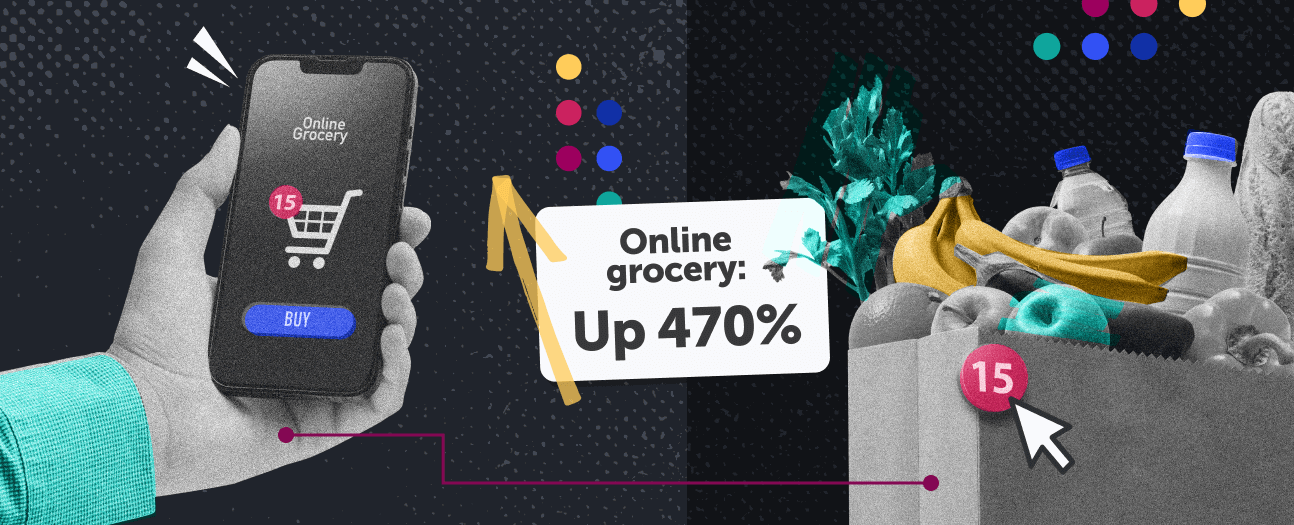
April 5, 2021
As the world adjusts to the effects of the COVID-19 pandemic, e-commerce has become a staple for consumers. According to Attentive online grocery data, food & beverage sales in the U.S. were up 41.6% in April compared to March, and 470.7% in March compared to February.
The spike in online grocery adoption creates significant opportunities and challenges for established brands, including how best to shift ad dollars to digital tactics that drive incremental online sales. With experts encouraging retailers to reduce the use of paper coupons to prevent exposing their employees to COVID-19, many CPGs are abandoning the FSI for safer digital alternatives that work in-store and online.
“Now more than ever, CPG brands recognize the importance of influencing purchase decisions for online grocery orders. Historically, there have been limited resources available to CPG marketers that can change purchase habits in real-time for e-commerce grocery retailers," said Erik Senescu, SVP of Client Partnership at Ibotta.
This is an exciting new era for shopper marketing, where the potential for sustained growth exists for those who effectively disrupt the digital point-of-sale with tactics that drive transactions and deliver accurate real-time purchase insights.
Shifting Role of CPG Marketers
CPGs have adapted their strategy to support the needs of Millennial shoppers and the rise of online grocery adoption. Roughly 60% of all media budgets will be spent on digital in 2020, surpassing every other platform including TV and print. This could be challenging for some CPG marketers who traditionally relied on outdoor advertising, in-store media, or paper coupons to drive sales volume. The online experience is a different landscape altogether. It is search-based and responsive to purchase intent, which creates opportunity for CPGs who can meet shoppers at critical touchpoints in the online environment
With experts expecting it will take years for the economy to recover, shoppers are increasingly looking for ways to stretch their dollars. Inmar Intelligence reported that digital offer redemption increased 56.5% industrywide in March 2020. Perhaps even more significantly, the pandemic has led to a significant volume of shoppers trying these programs for the first time, with the top 30% of national grocery chains experiencing a 93% year-over-year increase in digital rewards enrollment. This comes at a time when paper coupons are experiencing significant challenges related to COVID-19.
Sustainable Promotions
In addition to the rise of digital promotions, paper coupons are experiencing heightened safety concerns, and public demand for easier opt-out.
Futerra surveyed 1,000 shoppers in the U.S. and found 88% want brands to help them be more environmentally friendly, which has led major companies to demonstrate their corporate values by emphasizing sustainability efforts related to sourcing, manufacturing, and packaging. Yet most retailers and brands have not acknowledged the environmental impact of moving away from paper coupons.
Borrell Associates conducted a study in April 2018 that estimates 13.62 million trees are used to make paper coupons each year. NCH U.S. CPG Coupon Facts reports a mere 0.67% of paper coupons get redeemed. This means 37,000 trees are wasted every day on unused paper coupons.
Ibotta is partnering with CPGs to engage shoppers in purpose-driven ways that work in the online grocery environment. See how Ibotta’s first annual Earth Month event delivered more than 130 million media impressions through our largest omnichannel campaign to date including TV, PR, social media, sweepstakes, an in-app takeover, push notifications, email and more.
Covid-19 and Coupons
While COVID-19 primarily spreads through exposure to respiratory droplets from an infected person who coughs, sneezes, or talks nearby, the Centers for Disease Control and Prevention has warned that the virus can survive for up to three hours on paper. As a result, experts have encouraged retailers to reduce the use of paper coupons and cash to prevent exposing their employees to a deadly disease.
When the world changed overnight CPGs were stuck with paper coupon plans finalized months before. Digital is adaptable in real-time and performance-based, which removes the risk of non-working dollars. Digital offers also provide an opportunity for brands and retailers to help shoppers when they need it most, while reducing safety concerns and moving away from archaic paper tactics that degrade the environment, have no ability to deliver real-time purchase insights, and can’t be used online.
On the death of paper coupons
“The opportunity for CPG suppliers becomes how can retail sales teams more effectively collaborate with category buyers when 95% of trade marketing events are no longer tied to FSI drops?” Blacksmith Applications product manager Joel Cartwright said. “Digital tactics can be segmented from trade marketing events for better ROI analysis. The upside of digital marketing is realtime sales insights or accurate shopper identity graphs that would outweigh any [potential] volume lost from FSIs.”
Moving Forward
COVID-19 has accelerated online grocery adoption and research says those gains are here to stay. The shift in consumer behavior changed the role of CPG marketers. Traditional tactics and in-store promotions alone are no longer enough. The new CPG promotional toolkit will meet shoppers where they are in-store and online, while delivering real-time purchase insights across all key channels.
For more information on how COVID-19 has changed shopper behavior check out Ibotta’s Mobile Rebate Industry Trends report, which uses proprietary data to track purchases across channels.
![]()
Achieve your brand goals
Which metrics are most important for your brand? Get in touch to explore possibilities with the Ibotta Performance Network.
